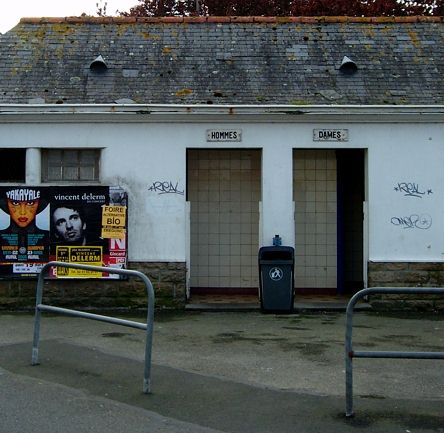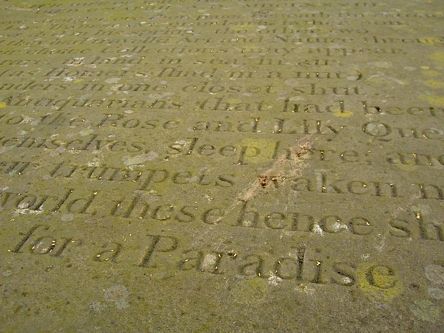|
4th april 2005
Mrs Luther walked up the aisle, leaned across Neale and spoke to me. "On behalf of the women of the party, is there a john here?" "I think so. I seem to remember - " I looked out. It was just to the left of the Customs building, with a steep staircase leading down to it. I pointed it out. "Would you very kindly take us?" Mrs Luther asked. "We don't speak the language." "You hardly need to. The word Dames - " from Brigid Brophy, The King of a Rainy Country
6th april 2005condemned to repeat itWell, I was close.
10th april 2005
1926 - 2005.
18th april 2005But they never played with the Samuel Josephs now or even went to their parties. The Samuel Josephs were always giving children's parties at the Bay and there was always the same food. A big washhand basin of very brown fruit-salad, buns cut into four and a washhand jug full of something the lady-help called 'Limonadear.' And you went away in the evening with half the frill torn off your frock or something spilled all down the front of your open-work pinafore, leaving the Samuel Josephs leaping like savages on their lawn. No! They were too awful.
from Katherine Mansfield, At the Bay
21st april 2005pierrot faché avec la luneWhen I think of the differing forms and styles of western classical music drama, the one which least appeals to me is ballet.
25th april 2005
The Tradescants were a little dynasty of royal gardeners and collectors of plants and curios: their joint tomb is in the churchyard of St Mary's Lambeth (now the Museum of Garden History) and carries this epitaph, written by John Aubrey of Brief Lives fame: Know, stranger, ere thou pass; beneath this stone,
Lye John Tradescant, grandsire, father, son; The last dy'd in his spring; the other two Liv'd till they had travelled Orb and Nature through, As by their choice Collections may appear, Of what is rare, in land, in sea, in air; Whilst they (as Homer's Iliad in a nut) A world of wonders in one closet shut. These famous Antiquarians that had been Both Gardiners to the Rose and Lily Queen, Transplanted now themselves, sleep here; and when Angels shall with their trumpets waken men, And fire shall purge the world, these hence shall rise And change this Garden for a Paradise. The grandsire was gardener to Charles I, introduced many plants into Britain and filled his house with curiosities. His son followed in this tradition and in a catalogue of his Museum Tradescantianum we find: Easter eggs of the patriarchs of Jerusalem; two feathers of the phoenix' tayle; claw of the bird Roc, who, as authors report, is able to truss an elephant; a natural dragon above two inches long; the Dodad1, from the isle of Mauritius, so big as not to be able to fly; the bustard, as big as a turkey, usually taken by greyhounds on Newmarket Heath; a cow's tail from Arabia; half a hazel-nut, with seventy pieces of household stuff in it; a set of chessmen in a peppercorn; landskips, stories, trees, and figures, cut in paper by some of the emperors; a trunnion2 of Drake's ship; knife wherewith Hudson was killed in Hudson's Bay; Anna Bullen's3 night-vail; Edward the Confessor's gloves.
He bequeathed this collection to Elias Ashmole, who passed it on to Oxford University where it formed the nucleus of the Ashmolean Museum. 1 Does the word doodad come from the word dodo? The Tradescant specimen is now in the Oxford University Museum
27th april 2005formicI prised the lid off the compost bin to see what was happening inside. There's always something weird going on: last time it was a civilization of fruit flies so complex and advanced they had already developed space travel, or at least radio broadcasts. Today the ants had taken over, and it seemed the bin was one big nest; but the odd thing was that the nursery was up on the surface of the top layer of grass clippings, the grubs all laid out in rows like patients in a sanatorium, as if to breathe better the hot foetid healthful air of the place. It must be dark in there, perhaps the ants didn't know quite where they were - or maybe they enjoy a kind of dark green twilight filtered through the plastic - and of course as soon as the lid came off all hell broke loose as the babies were whisked away to safety. Animals doing odd things always reminds me of my old zoology tutor: If we knew why they did that, he'd say with an entirely spurious air of wisdom, If we knew why they did that, we'd know an awful lot more about ants.
|
Mediocre art is far worse than bad art. Bad art does not waste our time.
- Don Paterson |



